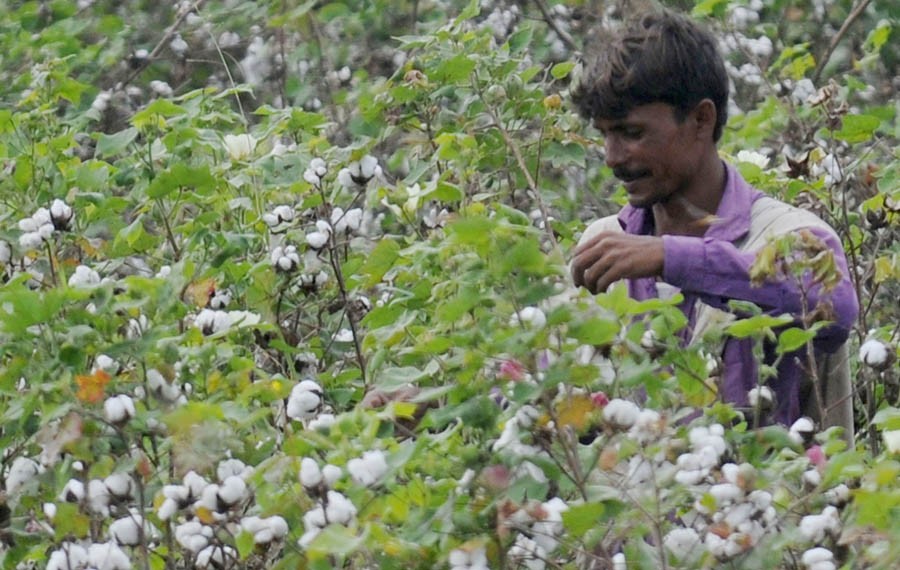
Lack of water, low quality seed and bad policies are proving detrimental to the cotton crop and textile industry

Pakistan is the 8th largest exporter of textile commodities in Asia. The sector contributes 8.5 per cent to the GDP of Pakistan, where 1.3 million farmers utilise 7.3 million acres of land for cotton crop and 45 per cent of the total labour force is employed. Nonetheless, farmers, labour and mill owners are disillusioned with the existing circumstances and the future of cotton market and textile industry.
Ghani Talpur, a farmer of Jamshoro, Sindh, owns twelve acres of agriculture land and cotton is his core crop of the year. However, this season has brought a number of problems and hitches for his cotton produce.
"Water scarcity is badly affecting the crop which is causing huge losses to farmers," Ghani Talpur states. "Lack of water prevented me from cultivating cotton on half of my farmland. Moreover, the costs of inputs have compelled farmers to either keep their land uncultivated or sow any other crop to earn their livelihood."
According to a USDA (United States Department of Agriculture) report published in 2015, cotton is grown as an industrial crop on 15 per cent of Pakistan’s farmland. Although Sindh and Punjab are the major producers of cotton, Balochistan and Khyber Pakhtunkhwa also contribute a small percentage.
"It is unfortunate that this share is plummeting rapidly for the last couple of years. We observe a 22 per cent cut in cotton production this year which is a grave indicator as to where our agri-business and the industry are heading," Central Secretary General Pakistan Kissan Ittehad, Mian Umair, tells TNS. "Sindh is critically affected this year. Water shortage and bad arrangements by the previous federal government have put farmers and the industry in a catastrophic situation."
Low quality seed is another principal factor being lamented by farmers and business units connected with the crop. Ballgrad-1 or BT cotton seed is mostly used by farmers. However, local varieties are available as well.
"Ballgrad-1 is not being used anywhere in the world except Pakistan. It is an outdated and expired variety. Ballgrad-2, which was being used in India and China, has also been proclaimed outdated now," Director Farmers’ Association, Rabia Sultan, tells TNS. "Because of Ballgrad-1, cotton crop has become fragile and less resilient to pest attacks. Consequently, more pesticides are used to kill pests which put more extra stress on the already frail plant. This procedure lessens the overall production. Moreover, local made varieties are inept of producing quality cotton."
The government is taking Rs700 million per year from the textile industry in the name of research. The government has also imposed Rs50 tax per bale on the purchase of both local and imported cotton. Nevertheless, from farmers to the industrialists, everyone is unsatisfied with the research being conducted in different institutes.
"The money the government collects for research is being utilised to pay salaries of the Agriculture Department. In fact, the policies introduced by the previous government have hit the agriculture and textile industry so badly that it would take several years and earnest efforts to regain our chunk in the international market," Secretary APTMA (All Pakistan
Textile Mills Association) Anis ul Haq says.
"Inputs for agriculture sector, electricity and gas for industry are too expensive to compete in the world market. In place of cotton, farmers are now turning to sugarcane."
The representatives of APTMA have been protesting against 11 per cent import duty imposed by the previous government which includes 6 per cent custom and 5 per cent sales tax. "This policy, which was announced on the last day of the PML-N’s government, proved to be the last nail in the coffin of the cotton industry. 125 out of 400 textile mills have been shut in the last four years. Export deficit has reached 1.5 billion dollars a year," Anis ul Haq states. "Because of incompetent policies, local produce of cotton is incapable of fulfilling the demand of textile industry. Therefore, we have to import cotton from India which has been made impossible through the imposition of import duty."
"Electricity, pesticides, fertilizer and labour have been so costly that farmers cannot afford to cultivate cotton crop," Mian Umair states. "The price of pesticides has been increased by more than 100 per cent but the average price of cotton is decreased from Rs5000 to 2200 per maund in the last three years."
"I disagree. Because the price is around Rs4500 per maund this year and I am convinced it doesn’t bring any comfort to a farmer," Anis ul Haq says. "Low quality raw material costs textile industry heavily which is why we are helpless in increasing the price."
It is the responsibility of the government to facilitate farmers by offering them subsidy on inputs like India gives, he adds.